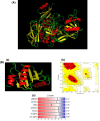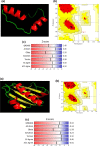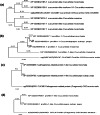Computational approach for the identification of putative allergens from Cucurbitaceae family members
- PMID: 33505071
- PMCID: PMC7813966
- DOI: 10.1007/s13197-020-04539-7
Computational approach for the identification of putative allergens from Cucurbitaceae family members
Abstract
Certain substances referred to as allergens, induce hypersensitivity (allergic reactions) which normally are considered to be innocuous, are small in size and incite IgE response. This study was focused to predict the putative allergens from other Cucurbitaceae family members using computational approach by analyzing the already reported allergens of the same family. The four reported allergens Cuc m 1, Cuc m 2, Cuc m 3 and Citr I 2 of Cucurbitaceae family were obtained from International Union of Immunological Societies, in which three were from Cucumis melo (Muskmelon) and one from Citrullus lanatus (Watermelon) respectively. BlastP analysis reported 44 similar sequences to these allergens from other members of Cucurbitaceae family namely Cucurbita moschata, Cucurbita pepo and Cucurbita maxima. The allergenicity of these sequences was predicted using AlgPred tool in which it revealed 26 protein sequences as putative allergens. These selected sequences were further analyzed for their physicochemical properties using ProtParam tool in which 13 sequences were found to satisfy the required parameters, and therefore further analyzed by AllerMatch™ and AllergenOnline tools to check the Codex Alimentarius rules for allergens. Finally, 13 sequences that were selected were structurally analyzed for similarity using PROMALS3D tool and phylogenetic relationship was established with the reported allergens using MEGA-X software. It was concluded that 13 sequences from Cucurbitaceae family belonging to different species of Pumpkin showed potential allergenicity based on the computational analysis that possibly can play a role in allergies and cross reactivity.
Keywords: Allergenicity prediction; Allergens; Cucurbitaceae; Phylogenetic analysis; Structural proteomics.
© Association of Food Scientists & Technologists (India) 2020.
Figures



Similar articles
-
A Genome-Wide Identification and Comparative Analysis of the Heavy-Metal-Associated Gene Family in Cucurbitaceae Species and Their Role in Cucurbita pepo under Arsenic Stress.Genes (Basel). 2023 Sep 27;14(10):1877. doi: 10.3390/genes14101877. Genes (Basel). 2023. PMID: 37895226 Free PMC article.
-
Identification of putative and potential cross-reactive chickpea (Cicer arietinum) allergens through an in silico approach.Comput Biol Chem. 2013 Dec;47:149-55. doi: 10.1016/j.compbiolchem.2013.08.003. Epub 2013 Sep 17. Comput Biol Chem. 2013. PMID: 24099701
-
Two New Allergens in Watermelon (Citrullus lanatus) Allergy.J Investig Allergol Clin Immunol. 2023 Feb 17;33(1):59-61. doi: 10.18176/jiaci.0804. Epub 2022 Mar 2. J Investig Allergol Clin Immunol. 2023. PMID: 35234643 No abstract available.
-
Selected Species of the Cucurbitaceae Family Used in Mexico for the Treatment of Diabetes Mellitus.Molecules. 2022 May 26;27(11):3440. doi: 10.3390/molecules27113440. Molecules. 2022. PMID: 35684376 Free PMC article. Review.
-
AllergenOnline: A peer-reviewed, curated allergen database to assess novel food proteins for potential cross-reactivity.Mol Nutr Food Res. 2016 May;60(5):1183-98. doi: 10.1002/mnfr.201500769. Epub 2016 Mar 3. Mol Nutr Food Res. 2016. PMID: 26887584 Review.
Cited by
-
Safety evaluation of the food enzyme oryzin from the non-genetically modified Aspergillus ochraceus strain AE-P.EFSA J. 2024 Apr 17;22(4):e8713. doi: 10.2903/j.efsa.2024.8713. eCollection 2024 Apr. EFSA J. 2024. PMID: 38634008 Free PMC article.
-
Allergenic Properties and Molecular Characteristics of PR-1 Proteins.Front Allergy. 2022 Feb 8;3:824717. doi: 10.3389/falgy.2022.824717. eCollection 2022. Front Allergy. 2022. PMID: 35386656 Free PMC article. Review.
-
Safety evaluation of the food enzyme subtilisin from the non-genetically modified Bacillus paralicheniformis strain DP-Dzx96.EFSA J. 2023 Aug 1;21(8):e08155. doi: 10.2903/j.efsa.2023.8155. eCollection 2023 Aug. EFSA J. 2023. PMID: 37533747 Free PMC article.
-
Safety evaluation of a food enzyme containing bacillolysin and subtilisin activities from the non-genetically modified Bacillus amyloliquefaciens strain AR-383.EFSA J. 2024 May 13;22(5):e8779. doi: 10.2903/j.efsa.2024.8779. eCollection 2024 May. EFSA J. 2024. PMID: 38741669 Free PMC article.
References
LinkOut - more resources
Full Text Sources
